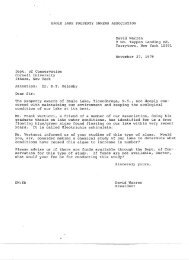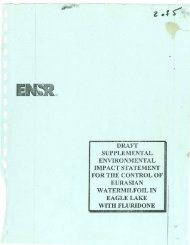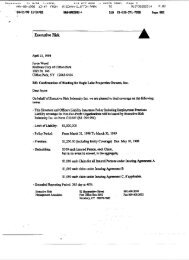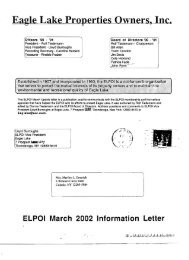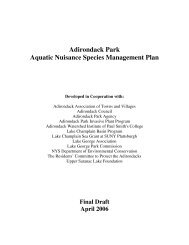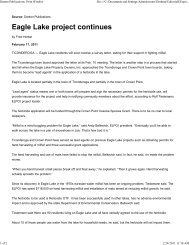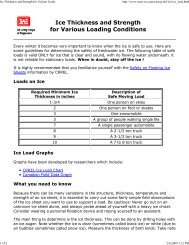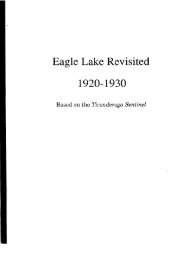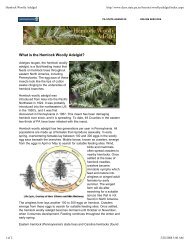Maine Field Guide to Invasive Aquatic Plants - Brant Lake Milfoil ...
Maine Field Guide to Invasive Aquatic Plants - Brant Lake Milfoil ...
Maine Field Guide to Invasive Aquatic Plants - Brant Lake Milfoil ...
You also want an ePaper? Increase the reach of your titles
YUMPU automatically turns print PDFs into web optimized ePapers that Google loves.
CURLY-LEAF PONDWEED<br />
Potamoge<strong>to</strong>n crispus<br />
NOT NATIVE TO MAINE - INVASIVE<br />
I N V A S I V E P L A N T S<br />
Habitat: Curly-leaf pondweed is found in the submersed plant<br />
community. Generally preferring soft sediments, it grows in waters<br />
that are shallow or deep, still or flowing. Curly-leaf thrives where<br />
many other aquatic plants do not, for example in waters that are<br />
shaded, disturbed, polluted or turbid.<br />
Description: Curly-leaf pondweed has submersed leaves only.<br />
(Some pondweeds have two distinct leaf types: submersed leaves<br />
and floating leaves.) Slightly flattened stems emerge from slender<br />
rhizomes and sprouting turions, often branching profusely as they<br />
grow, giving the plants a bushy appearance. Mature stems may be<br />
several meters in length. The leaves of this plant are key <strong>to</strong> its identification.<br />
Though the leaves share characteristics with some native<br />
pondweeds, they also have three distinct characteristics that set this<br />
plant apart from any of its native look alikes. (See table on page 40.)<br />
Stipules, when visible, (they disintegrate early in the plant’s growth<br />
cycle) are slightly joined <strong>to</strong> the stem at the leaf base and 4 <strong>to</strong> 10 mm<br />
long. Flower spikes appear above the surface of the water from June<br />
through September. The small flowers are<br />
tightly arranged at the end of a slender (often<br />
curving) stalk measuring about 7 cm in length.<br />
fruit<br />
The fruits have a prominent cone-shaped beak<br />
and a bumpy, crown-like ridge. (The shape<br />
resembles the profile of a crested woodpecker.)<br />
Turions form in the leaf axils during the growing<br />
season. The turions are hard but flexible (like<br />
stiff plastic) and typically 1 <strong>to</strong> 2 cm long.<br />
1 CM<br />
leaf<br />
turion<br />
Alternately arranged submersed-leaves<br />
38 <strong>Maine</strong> Volunteer <strong>Lake</strong> Moni<strong>to</strong>ring Program



